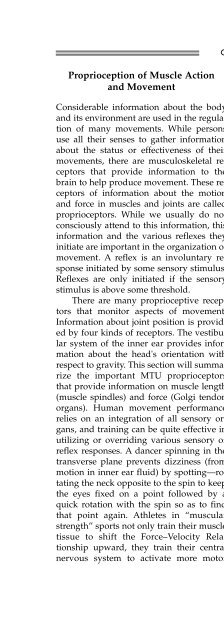Fundamentals of Biomechanics
Fundamentals of Biomechanics
Fundamentals of Biomechanics
You also want an ePaper? Increase the reach of your titles
YUMPU automatically turns print PDFs into web optimized ePapers that Google loves.
Proprioception <strong>of</strong> Muscle Action<br />
and Movement<br />
Considerable information about the body<br />
and its environment are used in the regulation<br />
<strong>of</strong> many movements. While persons<br />
use all their senses to gather information<br />
about the status or effectiveness <strong>of</strong> their<br />
movements, there are musculoskeletal receptors<br />
that provide information to the<br />
brain to help produce movement. These receptors<br />
<strong>of</strong> information about the motion<br />
and force in muscles and joints are called<br />
proprioceptors. While we usually do not<br />
consciously attend to this information, this<br />
information and the various reflexes they<br />
initiate are important in the organization <strong>of</strong><br />
movement. A reflex is an involuntary response<br />
initiated by some sensory stimulus.<br />
Reflexes are only initiated if the sensory<br />
stimulus is above some threshold.<br />
There are many proprioceptive receptors<br />
that monitor aspects <strong>of</strong> movement.<br />
Information about joint position is provided<br />
by four kinds <strong>of</strong> receptors. The vestibular<br />
system <strong>of</strong> the inner ear provides information<br />
about the head's orientation with<br />
respect to gravity. This section will summarize<br />
the important MTU proprioceptors<br />
that provide information on muscle length<br />
(muscle spindles) and force (Golgi tendon<br />
organs). Human movement performance<br />
relies on an integration <strong>of</strong> all sensory organs,<br />
and training can be quite effective in<br />
utilizing or overriding various sensory or<br />
reflex responses. A dancer spinning in the<br />
transverse plane prevents dizziness (from<br />
motion in inner ear fluid) by spotting—rotating<br />
the neck opposite to the spin to keep<br />
the eyes fixed on a point followed by a<br />
quick rotation with the spin so as to find<br />
that point again. Athletes in “muscular<br />
strength” sports not only train their muscle<br />
tissue to shift the Force–Velocity Relationship<br />
upward, they train their central<br />
nervous system to activate more motor<br />
CHAPTER 4: MECHANICS OF THE MUSCULOSKELETAL SYSTEM 99<br />
units and override the inhibitory effect <strong>of</strong><br />
Golgi tendon organs.<br />
When muscle is activated, the tension<br />
that is developed is sensed by Golgi tendon<br />
organs. Golgi tendon organs are located at<br />
the musculotendinous junction and have<br />
an inhibitory effect on the creation <strong>of</strong> tension<br />
in the muscle. Golgi tendon organs<br />
connect to the motor neurons <strong>of</strong> that muscle<br />
and can relax a muscle to protect it from<br />
excessive loading. The intensity <strong>of</strong> this autogenic<br />
inhibition varies, and its functional<br />
significance in movement is controversial<br />
(Chalmers, 2002). If an active muscle were<br />
forcibly stretched by an external force, the<br />
Golgi tendon organs would likely relax that<br />
muscle to decrease the tension and protect<br />
the muscle. Much <strong>of</strong> high speed and high<br />
muscular strength performance is training<br />
the central nervous system to override this<br />
safety feature <strong>of</strong> the neuromuscular system.<br />
The rare occurrence <strong>of</strong> a parent lifting part<br />
<strong>of</strong> an automobile <strong>of</strong>f a child is an extreme<br />
example <strong>of</strong> overriding Golgi tendon organ<br />
inhibition from the emotion and adrenaline.<br />
The action <strong>of</strong> Golgi tendon organs is<br />
also obvious when muscles suddenly stop<br />
creating tension. Good examples are the<br />
collapse <strong>of</strong> a person's arm in a close wrist<br />
wrestling match (fatigue causes the person<br />
to lose the ability to override inhibition) or<br />
the buckling <strong>of</strong> a leg during the great loading<br />
<strong>of</strong> the take-<strong>of</strong>f leg in running jumps.<br />
Muscle spindles are sensory receptors<br />
located between muscle fibers that sense<br />
the length and speed <strong>of</strong> lengthening or<br />
shortening. Muscle spindles are sensitive to<br />
stretch and send excitatory messages to activate<br />
the muscle and protect it from<br />
stretch-related injury. Muscle spindles are<br />
sensitive to slow stretching <strong>of</strong> muscle, but<br />
provide the largest response to rapid<br />
stretches. The rapid activation <strong>of</strong> a quickly<br />
stretched muscle (100–200 ms) from muscle<br />
spindles is due to a short reflex arc. Muscle<br />
spindle activity is responsible for this myo-






